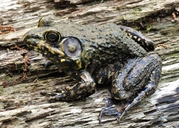|
Rana heckscheri Wright, 1924
River Frog Subgenus: Aquarana | family: Ranidae genus: Rana |
|
Taxonomic Notes: This species was placed in the genus Lithobates by Frost et al. (2006). However, Yuan et al. (2016, Systematic Biology, doi: 10.1093/sysbio/syw055) showed that this action created problems of paraphyly in other genera. Yuan et al. (2016) recognized subgenera within Rana for the major traditional species groups, with Lithobates used as the subgenus for the Rana palmipes group. AmphibiaWeb recommends the optional use of these subgenera to refer to these major species groups, with names written as Rana (Aquarana) catesbeiana, for example. |
|
 © 2010 Stephen Bennett (1 of 13) |
|
|
|
Description Distribution and Habitat Country distribution from AmphibiaWeb's database: United States. Introduced: China. U.S. state distribution from AmphibiaWeb's database: Alabama, Florida, Georgia, Mississippi, North Carolina, South Carolina
Life History, Abundance, Activity, and Special Behaviors
References
Sanders. A. E. (1963). ''Rana heckscheri. River Frog.'' Catalogue of American Amphibians and Reptiles. American Society of Ichthyologists and Herpetologists, 348.1-348.2. Originally submitted by: Franziska Sandmeier (first posted 2001-02-21) Species Account Citation: AmphibiaWeb 2001 Rana heckscheri: River Frog <https://amphibiaweb.org/species/5048> University of California, Berkeley, CA, USA. Accessed Jun 6, 2025.
Feedback or comments about this page.
Citation: AmphibiaWeb. 2025. <https://amphibiaweb.org> University of California, Berkeley, CA, USA. Accessed 6 Jun 2025. AmphibiaWeb's policy on data use. |




 Map of Life
Map of Life